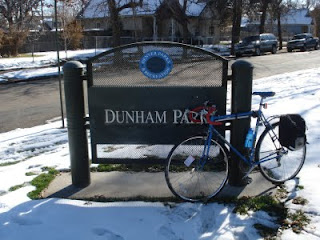Denver's rankings in T4A's "Dangerous by Design" report
Transportation for America released its Dangerous By Design report this week. The report assesses the danger of walking in major US metropolitan areas, and ranks the cities according to their Pedestrian Danger Index.
Fifty two metro areas were assessed. Denver ranked 23, with a PDI of 75.6, which makes it more dangerous than 55% of other areas. We're off the average of 77.4 by 1.8 points.
It is interesting to note that the ten most dangerous metro areas are all in the south, with the top four all being in Florida (Orlando/Kissimmee, Tampa/St. Petersburg/Clearwater, Miami/Fort Lauderdale/Pompano Beach, and Jackson). Having spent nearly all of my formative years in the south, I have to say this doesn't surprise me. It has been my experience that roads often narrow and lack sidewalks, and traffic flows through much too fast through residential and commercial areas alike.
Another table in the report shows the absolute number of pedestrian deaths, unadjusted—as the PDI is—for the number of people walking to work. Denver is tied for ninth most dangerous on this list with San Diego.
So absolute number of pedestrians killed by traffic in Denver is well above the norm, but because we have a proportionately large number of people walking to work, our PDI index is close to average.
New York City occupies a unique place on this list. It has among the highest number of actual deaths, and one of the lowest PDIs. Because they have by far the largest number of pedestrian commuters: 6% of all commuters, compared to an average among the other large metro area of 2.2%
Another figure reported is the average federal funds spent each year, per person, on biking/walking projects. Denver allocates $0.65 of its transportation budget, which gives it a ranking of 42/52 on this list. Bottom 10.
Interestingly, Tampa and Jacksonville, the 2nd and 4th most dangerous cities, are near the top of this list, shelling out $1.86 and $2.25 respectively. This is encouraging because it leads one to assume that the cities have recognized and are addressing the dangers detailed in this report.
Here are the figures for the other parts of Colorado.
| Safety Rank within state | Metro Area | Pedestrian Danger Index | Total Ped. Fatalities (2007-2008) | % of Traffic Deaths that were pedestrians | Avg Yr Fed $ spent per person | % workers walking to work | 2008 Population |
| 1 | Denver-Aurora | 75.6 | 79 | 20.4% | $0.65 2.1% | 2,506,626 |
| 2 | Grand Junction | 38.2 | 3 | 7.0% | $1.33 | 2.8% | 143,171 |
| 3 | Pueblo | 34.1 | 2 | 4.1% | $1.08 | 1.9% | 156,737 |
| 4 | Greeley | 21.4 | 3 | 3.3% | $0.41 | 2.9% | 249,775 |
| 5 | Boulder | 16.7 | 4 | 10.5% | $3.55 | 4.1% | 293,161 |
| 6 | Fort Collins-Loveland | 12.6 | 2 | 3.9% | $1.73 | 2.7% | 292,825 |
| 7 | Colorado Springs | 6.7 | 3 | 3.4 | $0.69 | 3.7% | 617,714 |
Denver is obviously the most dangerous place to walk. Hopefully that will change as our
Living Streets task force begins accomplishing tasks.
LAB's "Bicycle Friendly Communities" with Pedestrian Danger Index
The
League of American Bicyclists maintains a
list of "Bike Friendly Communities." as part of their Bicycle Friendly America program. Communities are evaluated on "the 5 Es" (Engineering, Education, Encouragement, Enforcement, and Evaluation & Planning) and a 28 page whopper of an application submitted by a representative of the community.
T4A's Pedestrian Danger Index cannot be applied directly to this list because the areas are defined differently. T4A defines "metro areas" such as Denver-Aurora, with a population of over 2 million. LAB "communities" tend to be defined by city boundaries, giving Denver a population just over 550,000.
But anyway, for curiosity's sake here are all cities in the top two tiers (Platinum, and gold) with, where available, the corresponding PDI.
| City/Community | Rank | PDI |
| Boulder, Colorado | Platinum | 16.7 |
| Davis, California | Platinum | Not available |
Portland, Oregon
(PDI includes data from Vancouver and Beaverton) | Platinum | 36.4 |
| Corvallis, Oregon | Gold | 7.9 |
Eugene, Oregon
(PDI includes data from Springfield) | Gold | 31.3 |
Fort Collins, Colorado
(PDI includes data from Loveland) | Gold | 12.6 |
| Jackson, Wyoming | Gold | Not available |
| Madison, Wisconsin | Gold | 7.8 |
| Palo Alto | Gold | Not available |
San Fransisco, California
(PDI includes data from Oakland and Freemont.) | Gold | 40.9 |
Seattle, Washington
(PDI includes data from Tacoma and Bellevue.) | Gold | 31.1 |
| Stanford University, California | Gold | Not available. |
| Tucson/East Pima, Arizona | Gold | 72.8 |
Like I said, you can't really apply the PDI directly to this list, but it's interesting nonetheless.
That's all for now. I'm going to keep pouring through this report.














